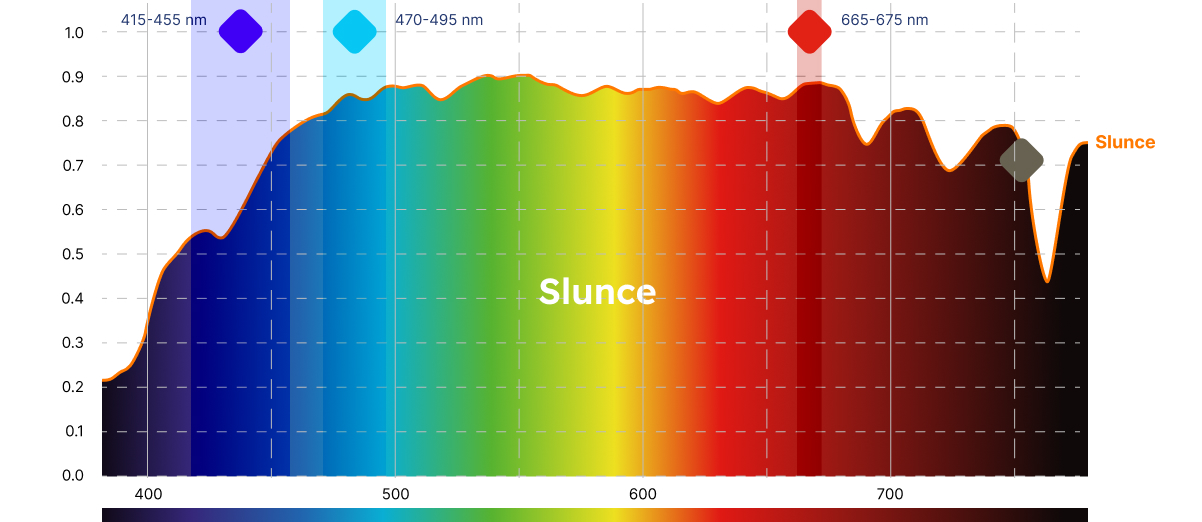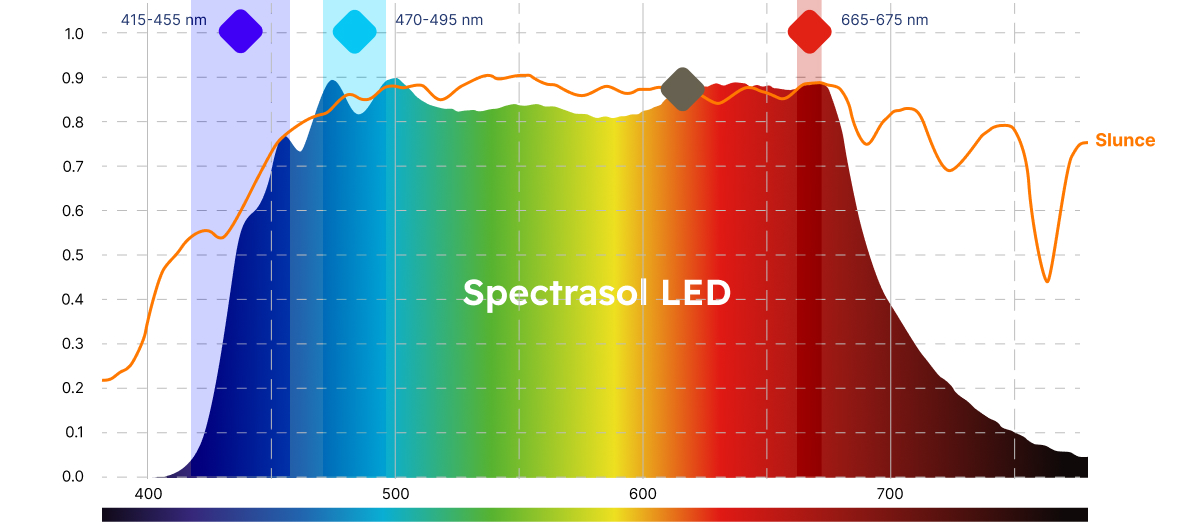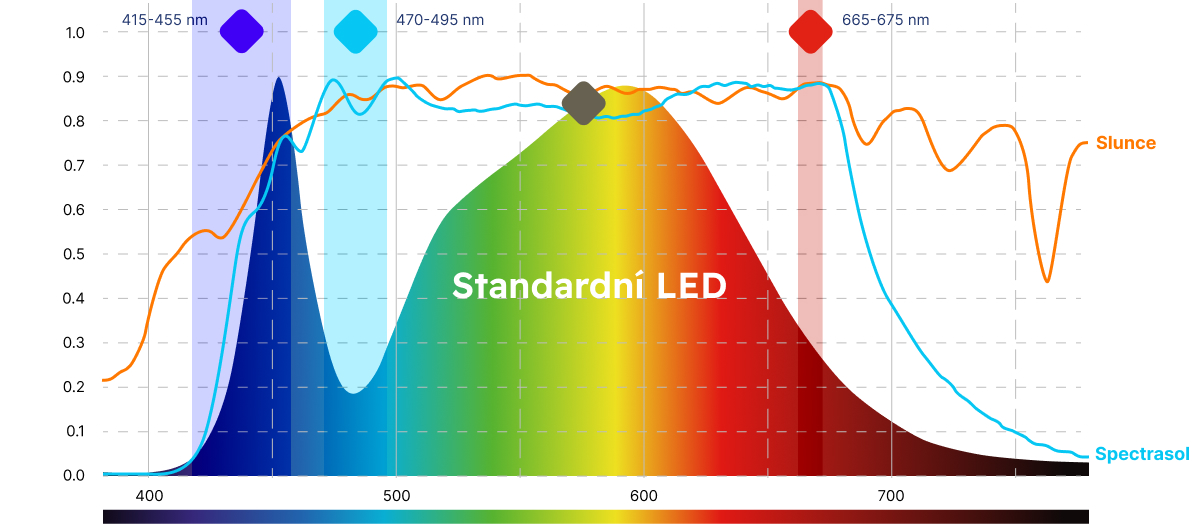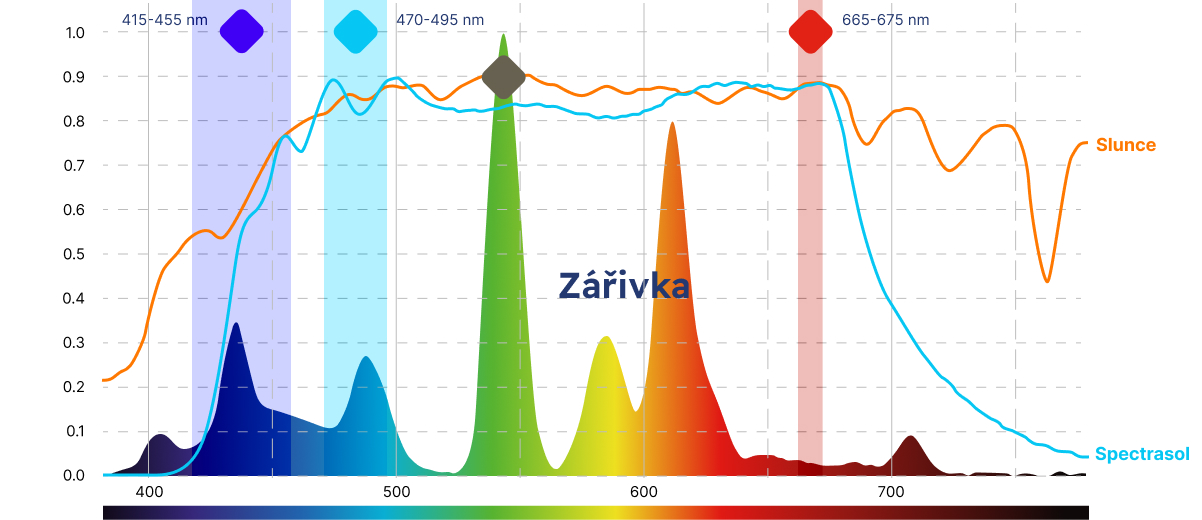Spectrasol technology
Spectrum closest to sunlight
Sunlight. What is important? What are the healthy and harmful components of light?
Spectral balance
During a clear day, the sun emits white light with a fully balanced spectral composition, free of dips and peaks. The solar spectrum is broader than the visible spectrum as the sun also emits ultraviolet (UV) and infrared radiation, which is not suitable for the electric lighting of buildings.
The quality of a lighting fixture is determined by how balanced and continuous the spectral composition (SPD) of a given light source is and how well it mimics the sun.
Cognitive melanopic energy
460–500 nm
The energy in the spectral range of around 480 nm is crucial for regulating the effects of light on our body through the eye’s non-image-forming (NIF) system. It supports circadian rhythms that signal the body that it is day, evening or night. During the day it maintains vigour, alertness and cognitive function. At the same time it stimulates the production of serotonin, a daytime hormone that in the evening transforms into the night-time recovery hormone melatonin. It also affects mood and long-term health.
The sun, with its full spectral composition containing cyan wavelengths, provides balanced melanopic energy, essential for the functioning of our biological clockwork.
Harmful blue light energy
415–455 nm
Harmful blue light (HBL) in this spectral range poses an undesirable risk to the retina of the eye and can significantly contribute to macular degeneration. It generates free radicals, which pose a risk even at low intensity if the exposure is prolonged. Even though the sun also emits harmful blue light, the photobiomodulation effect of the long red wavelengths in its spectrum compensates for these negative effects.
Regenerative photobiomodulation energy (PBM)
The regenerative photobiomodulation (PBM) energy in the red long wavelength region of around 670 nm has a significant photoprotective function. The energy helps offset the negative effects of harmful blue light (HBL) by eliminating free radicals in the retina through the production of antioxidants, thereby protecting the health of the eye. The sun naturally emits a continuous and balanced energy in this area, which contributes to natural protection and regeneration.
Spectrasol: Healthy light components fully represented and limited amount of undesirable components
Spectral balance
Cognitive melanopic energy
Spectrasol LED emits continuous and balanced energy across the entire visible spectrum. Like the sun, it is also balanced in the cyan procognitive region, thereby naturally supporting the circadian system during the day.
Harmful blue light energy
415–455 nm
Spectrasol, like all daylight sources, also emits blue light with a wavelength of around 450 nm, but unlike other LED light sources, the energy is not unnaturally concentrated, but is part of a continuous emission, just like in sunlight. In addition, its negative effects are naturally offset by radiation in the red photobiomodulation region of around 670 nm, as is the case with the sun.
Regenerative photobiomodulation energy (PBM)
The Spectrasol LED light source also uniquely emits balanced energy in the photobiomodulation region of the long red wavelengths of around 670 nm, thus compensating for, among other things, the negative effects of harmful blue light.

All that has been said is backed up by exact measurements
Measurement of the spectral composition of Spectrasol lights installed in a fire brigade control room in Prague. The radio spectrometer demonstrates the overall balance of the spectral composition, as well as the presence and correct intensity of both procognitive and regenerative energy.
Spectrasol lighting fixtures meet, with a good margin, all the parameters of procognitive lighting prescribed by the current and upcoming standards, which according to the recommendations of CIE as the highest global lighting authority will include the DERmel methodology – EDI Lux measurements taking into account the non-image forming biological effects of lighting in buildings.
Conventional LED:
unbalanced spectrum, concentrated blue energy, lack of red energy.
Spectral balance
Cognitive melanopic energy
A conventional LED light source typically shows a dip in radiation in the cyan melanopic region, preceded by concentrated energy in the blue wavelengths. This shortcoming is due to the fundamental technological limitations of the fluorescent material in conventional LED technologies.
Harmful blue light energy
For a standard LED light source, the typical maximum limit is 450 nm, but there are also ‘full-spectrum’ LED sources with more damaging to violet peaks already at around 420 nm.
Regenerative photobiomodulation energy (PBM)
A standard LED light source does not emit energy in the PBM region and thus does not compensate for the effects of harmful blue light.
Fluorescent lamp:
Discontinuous and incomplete spectrum farthest from sunlight
Spectral balance
Cognitive melanopic energy
A fluorescent lamp shows minimal radiation in this area.
Harmful blue light energy
A fluorescent lamp always emits unwanted short-wave energy in the HBL region starting at violet wavelengths.
Regenerative photobiomodulation energy (PBM)
A fluorescent lamp emits minimal to zero energy in this area.

Spectrasol light source
We ingeniously combine white and coloured LED chips to achieve exceptional balance and spectral composition that matches that of the sun on a clear day. At the same time we eliminate the undesirable effects of the harmful blue wavelengths of the emitted light.
The CCT, or correlated colour temperature, of the light from our fixtures of around 4,800 K corresponds to bright natural daylight. We also achieve an excellent CRI Ra colour fidelity index of more than 95.
Patent protected
The operating principle and design of Spectrasol fixtures are protected by two patents.


Manufacture in the Czech Republic
Spectrasol technology certification and verification
Spectrasol’s circadian, procognitive and photobiomodulatory effects have been verified by experimental studies conducted by the CTU, the National Institute of Mental Health, the European Biomedical and Biotechnology Centre BIOCEV and other scientific institutions. At the same time we have all certifications in accordance with the applicable standards.
ESG, WELL and EPD certification
We bring a unique solution in LED lighting that combines health and practical benefits with sustainability principles. Spectrasol’s patented technology is a tool for organisations seeking to meet their ESG goals and achieve WELL certification. Many of our lighting fixtures are also EPD certified.

WELL
With Veolia Spectrasol lighting you may qualify for a maximum of 3 points under Well certification.

EPD certified products
We monitor our carbon footprint in the development and manufacture, as well as in the marketing, use and disposal or recycling of our fixtures. We gradually obtain certification for the main product groups in our portfolio under the EPD system.









